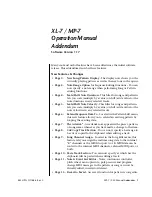
9
Informer Series C Overview
Setup, Program, and User Manual
Federal Signal www.fedsig.com
The digital inputs may also be configured using the Commander® application. The
Commander application will override web page configurations.
Web page configurations must be applied and the Informer must be rebooted before the
changes take effect.
Table 1 Input and Output Configuration
Product Family Number of Inputs Number of Outputs
I-IP-IO
N/A
N/A
I-IP15
4
2
I-IP100
4
2
I-IP2
N/A
N/A
I-IPSIU
16
4
Informer SIP Telephone Interface
The Informers can register with a standard SIP phone server and automatically answer
calls for live voice paging. Once a call is established with the Informer, the Informer
will listen for commands initiated from the phone’s keypad. Keypad commands can
be configured to activate locally stored WAV files, control relay outputs, and execute
preprogrammed functions, including volume control, relay output sequences, and tone
and voice message sequences.
To configure SIP setting, use the Informer’s integrated web server’s web page. SIP SDP,
secure SDP TLS, RTP, and RTP Telephone Events (RFC2833/4733) are supported. The
Informers include a configurable Jitter Buffer, Quality of Service (QoS), and support
redundant SIP servers to ensure high reliability for emergency communications.
Federal Signal offers complete SIP server and Gateway options that include paging to
speakers’ groups by dialing a single phone extension. Single button paging stations and
touchscreen phones with configurable call buttons are also available.
Informer Control using IP Phone Keypad
When a SIP phone call has been established with a Federal Signal Informer IP product, the
Informer is able to decode DTMF characters sent as RTP Telephone Events to activate the
Informer’s locally stored WAV files and preprogrammed functions. The DTMF Telephone
Events are initiated by pressing the 0-9, * (asterisk), and # (pound) keys on the phone’s
keypad on a SIP phone system that supports Telephone Events per RFC2833/4733. DTMF
audio from the control signals will not be heard from the Informer, and handset audio
will be interrupted while the Telephone Event is active to prevent unwanted noise while
control commands are being initiated. The Informer uses the DTMF * and # as start and
stop Framing Characters to frame numeric control commands. The * (asterisk) character is
used to frame WAV file playback commands, and the # (pound) character is used to frame
the Informer function control commands. These commands are explained in the Control
Command sections.
When the first DTMF (Start) framing character is received, the Informer starts reading
the control number digits for 5 seconds or until the second (Stop) framing character is
received or until an illegal character is received. Each digit received restarts the 5-second
timer. When the second framing character is received, the valid digits read will determine
the control command number. One to four digits, including the valid digit numbers 0-9
may be entered. If any character other than the framing characters or valid digit number










































